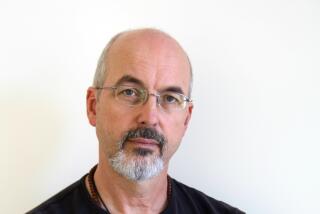Wilshire Center
- Share via
Wolfgang Laib, the German doctor who works small miracles with milk, pollen and rice, is almost too good to be true. His work is artlessly simple, virtually bereft of art world mumbo jumbo, rich in a sensory qualities and meaningful in an elemental--even humanitarian--way.
“Milkstone” (one of several such pieces) is a square slab of marble that projects just a few inches from the ground. To the casual viewer, that’s all it is. Actually, the top of the piece is indented slightly to receive a small quantity of milk. Topped off with the liquid--the universal symbol for nurturing--the marble becomes “whole.” Tricking the eye is just the beginning, easing the viewer into thoughts about the mutability of seemingly permanent things and the extraordinary nature of a liquid that sustains life.
In “Hazel Pollen Piece,” the intensely yellow substance the artist patiently collects makes a brilliant carpet on the floor, gradually mingling with the air to form a low-lying canary-colored haze: nature’s propagation system “amplified” into a sensory feast.
The “Rice Houses”--small, low-lying structures reminiscent of medieval reliquaries but filled with rice instead of the bones of saints--are essentially meditations on the preciousness of basic foodstuffs in a world in which millions go hungry. In “The Rice Meals,” small mounds of rice fill brass plates arranged in a pristine row on the floor.
The great gift of this work is the way Laib infuses concrete nature and food imagery with Eastern qualities of humility and ritual--not for their own sakes but to get the jaded Westerner to pay attention to a theme more important than any work of art. (Burnett Miller Gallery, 964 N. La Brea Ave., to Dec. 31.)
More to Read
The biggest entertainment stories
Get our big stories about Hollywood, film, television, music, arts, culture and more right in your inbox as soon as they publish.
You may occasionally receive promotional content from the Los Angeles Times.










